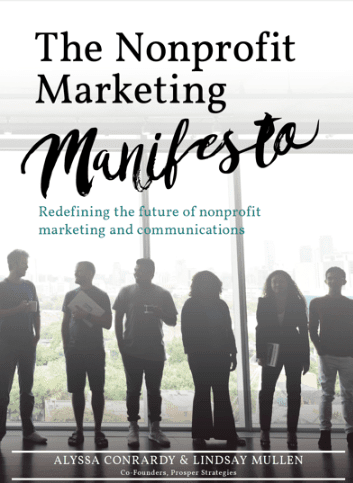At many nonprofits, marketing and fundraising are thought of as one in the same, and managed under a single department. This can be a big mistake, because marketing is much more than a tool for fundraising and development.
Of course, you can’t fundraise without marketing and communications, but fundraising is only one aspect of an organization’s success that marketing and communications can contribute to. While these functions are interdependent on one another, if you’re thinking that marketing only exists to advance fundraising, you’re thinking too small.
Here’s how we define and differentiate each of these important functions for the nonprofits we work with:
- Marketing comprises the activities, touchpoints and messages that motivate stakeholders to take actions that advance a nonprofit’s mission and create sustainable social change.
- Fundraising is the process of soliciting financial support for an organization by building, strengthening and sustaining relationships with individual donors, foundations, corporations and other supporters who are aligned with the organization’s mission and goals.
Let’s take a closer look at how marketing and fundraising are different and why they should exist as separate functions at your organization.
Marketing Has Many Intended Outcomes
Marketing and communications serve a larger purpose than shepherding potential donors through their relationship with your organization. Your marketing function (along with communications) is also necessary for raising general awareness about your organization, recruiting volunteers, and building relationships with other organizations and companies, as well as the people you serve and the community you operate within.
Not everyone your organization comes in contact with is a potential donor, but when marketing and fundraising are combined into one function, marketing often gets treated as if donors are the only audience that matters. That’s why we often consider it a mistake to treat marketing solely as a device to advance fundraising, and why it’s often harmful for marketing and fundraising to exist as a single department within a nonprofit organization.
Fundraising Has One Intended Outcome: Raising Money
Ultimately, fundraising serves one main purpose: raising money. But not everyone you need to promote your organization to is a donor, and not every prospective donor is ready to be asked to give.
That’s why it’s so important to develop and maintain relationships through marketing that have nothing to do with asking for funds. When it’s time for a major push, like an end-of-year fundraising campaign, your fundraising/development team should be able to build on existing relationships (nurtured through marketing) with people who know about and are interested in your organization.
Of course, it’s critical for marketing and fundraising to be closely coordinated, and for some marketing messages and touch points to reach prospective donors. But by treating these two functions as separate yet interrelated, you’re far more likely to be able to leverage the full potential of marketing to advance all of your organization’s goals, not just its financial ones.
But wait: how can we make sure nonprofit marketing and fundraising are aligned?
So, we’ve made the case for why marketing and fundraising are different, and why it’s important to treat them as separate functions at your nonprofit. But how can you do this, while also keeping both functions in lockstep with one another?
The answer to this question is easy: both marketing and fundraising should operate based on your organization’s overall strategic plan.
Everything marketing and fundraising do should be tied to specific goals that serve your organization’s overall mission and vision. Your strategic plan will inform both your fundraising plan and your marketing plan, and those two plans should also inform and coordinate with each other. This ensures clear alignment between marketing and fundraising, even when they operate as separate functions.
Your marketing and fundraising teams should also work closely together and collaborate on campaigns, messaging and materials development. Though your departments may (and probably should) be separate, the people who experience the things your organization puts out into the world rarely fit into one category (i.e. “just” a donor or “just” a volunteer). Organizations that have closely aligned, yet separate marketing and fundraising functions are typically far better equipped to build strong brands and provide a better experience to all their stakeholders, not just their donors.
Are you ready for your nonprofit marketing to do more than fundraise?
Expand your approach to marketing so you can fulfill your true potential for impact. Read about how you can make that happen at your organization in our Nonprofit Marketing Manifesto.
